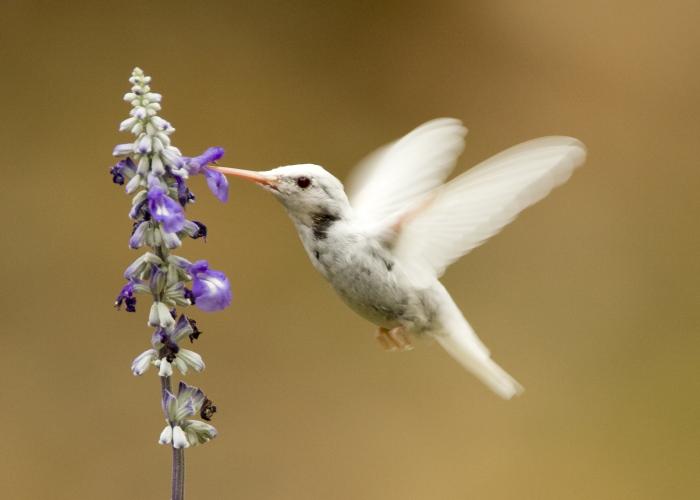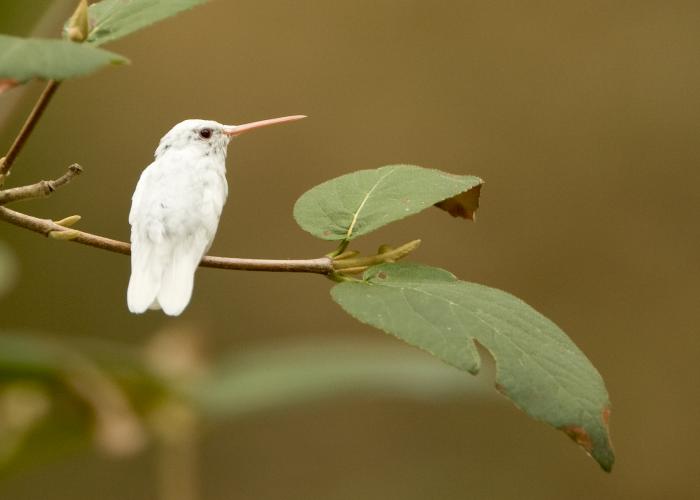
Xplor reconnects kids to nature and helps them find adventure in their own backyard. Free to residents of Missouri.


































Stay in Touch with MDC news, newsletters, events, and manage your subscription

Xplor reconnects kids to nature and helps them find adventure in their own backyard. Free to residents of Missouri.

A monthly publication about conservation in Missouri. Started in 1938, the printed magazine is free to residents of Missouri.




KANSAS CITY, Mo. -- An extremely rare albino hummingbird recently visited a feeder at a Lake Waukomis home in the Northland, and the bird may still be in the Kansas City area.
“She sure put some excitement in my days,” Nancy Morrison said. “It was great watching her.”
A normal ruby-throated hummingbird has a black bill, black eyes and black legs, with metallic green back and sides and a bright red patch across the throat. They’re commonly seen sipping nectar from flowers or sugar water from backyard bird feeders.
But on Aug. 8, birdwatchers Nancy and Michael Morrison spotted a white hummingbird with a pink beak, pink legs and pink eyes hovering at a feeder in their yard. The bird then visited the feeder daily or rested at a butterfly bush at the Morrison’s home in Lake Waukomis. Saturday, though, she noticed it was gone.
“I was pleased as punch to have her around,” Nancy Morrison said.
The length of the bill, body size and feature structures seem to indicate that it is a female ruby-throated hummingbird, said Bill Hilton Jr., an educator and naturalist in South Carolina who works extensively with the species.
The bird also appears to be a true albino, said Hilton, who has reviewed photographs. He receives from 30 to 40 reports a year about ruby-throated hummingbirds with white coloration at his website, www.rubythroat.org. Only three or four per year are true albinos.
“They are extremely rare,” Hilton said.
The white hummingbirds have poor survival rates because they stand out to predators, he said. The albino in Morrison’s yard was likely born this year in the Kansas City area. It will be lucky to survive migration when hummingbirds head to Central America and the Gulf Coast region for winter, Hilton said.
But this female is feisty.
“She flitted around and guarded her territory,” Morrison said. “She drove every other hummingbird out of here.”
Photographer Linda Williams dubbed the bird “a mean little fairy princess warrior.”
Morrison said she misses the ethereal beauty of the hummingbird flitting across her yard.
“Hopefully she’ll come back,” she said.
All hummingbirds could use some help during autumn migration, said Larry Rizzo, natural history biologist for the Missouri Department of Conservation (MDC). In normal years, hummingbirds can get plenty of nectar from flowers. Backyard hummingbird feeders help a bit but are mostly for bird watching enjoyment.
This year, however, drought has parched the Midwest. Flower availability is greatly reduced. Backyard hummingbird feeders can help fill the gap.
“I have to think that hummingbirds are kind of hunting for nectar,” Rizzo said. “This is one of the cases where they would definitely benefit from them.”
Some hummingbirds nest and stay in the Kansas City region through summer. But many more migrate southward through the area from northern states. The peak migration is now through September. The migrants mixed with resident birds increases the number of hummingbirds at feeders in this season.
Hummingbird feeders that hold liquid food with feeding areas that mimic flowers are commonly found at stores. It’s easy to make a feeding solution. Use four parts water to one part sugar. Heat just enough to melt the sugar into solution. Don’t use food coloring.
Rizzo also urges bird watchers who are interested in hummingbirds to keep feeders up into late November. Sometimes unusual species of hummingbirds from other regions migrate through in late autumn.
For more information on hummingbirds in Missouri, visit mdc.mo.gov.